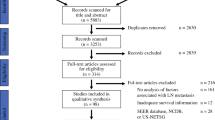Abstract
Background
The management of small (≤20 mm), nonfunctioning pancreatic neuroendocrine neoplasms (pNENs) remains under debate. The European Neuroendocrine Tumor Society guidelines advocate the possibility of a conservative approach.
Methods
A systematic literature search was conducted to identify all studies comparing the risk of malignancy in small pNENs with respect to large ones (>20 mm). Malignancy was defined based on the presence of nodal metastases. Distant metastases, tumor grading (G2–3), vascular microscopic invasion, stage III-IV, and overall and disease-free survival also were evaluated. The data were reported in two ways: using the risk difference (RD) and the likelihood of being helped or harmed (LHH).
Results
The search identified only 6 eligible studies with an overall population of 1697 resected pNENs: 382 (22.5%) small and 1315 (77.5%) large. The RD of lymph nodal metastases was −0.26 (95% confidence interval (CI): −0.31 to −0.22; P < 0.001). The LHH was 0.34, suggesting that the risk of leaving a malignancy during follow-up due to the adoption of a conservative strategy was three times higher than the benefits. The risk difference of distant metastases, G3 lesions, G2–G3 lesions, stage III/IV, microscopic vascular invasion, death, and recurrence of the disease were lower in small NF-PNETs than large ones. The related LHH values suggested that a watch-and-wait policy never provided a benefit.
Conclusions
Even if the malignancy rate in sporadic, small pancreatic neuroendocrine neoplasms was lower than in large ones, this difference did not justify a watch-and-wait policy.


Similar content being viewed by others
References
Falconi M, Eriksson B, Kaltsas G, et al. ENETS Consensus Guidelines Update for the management of patients with functional pancreatic neuroendocrine tumors and non-functional pancreatic neuroendocrine tumors neuroendocrinology. 2016;103:153–71.
Gaujoux S, Partelli S, Maire F, et al. Observational study of natural history of small sporadic nonfunctioning pancreatic neuroendocrine tumors. J Clin Endocrinol Metab. 2013;98:4784–9.
Lee LC, Grant CS, Salomao DR, et al. Small, nonfunctioning, asymptomatic pancreatic neuroendocrine tumors (PNETs): role for non operative management. Surgery. 2012;152:965–74.
Kuo EJ, Salem RR. Population-level analysis of pancreatic neuroendocrine tumors 2 cm or less in size. Ann Surg Oncol. 2013;20:2815–21.
Sharpe SM, In H, Winchester DJ, Talamonti MS, et al. Surgical resection provides an overall survival benefit for patients with small pancreatic neuroendocrine tumors. J Gastrointest Surg. 2015;19:117–23.
Kim MJ, Choi DW, Choi SH, et al. Surgical strategies for non-functioning pancreatic neuroendocrine tumours. Br J Surg. 2012;99:1562–8.
Ricci C, Casadei R, Taffurelli G, et al. Validation of the 2010 WHO classification and a new prognostic proposal: A single centre retrospective study of well-differentiated pancreatic neuroendocrine tumours. Pancreatology. 2016;16:403–10.
Fischer L, Bergmann F, Schimmack S, et al. Outcome of surgery for pancreatic neuroendocrine neoplasms. Br J Surg. 2014;101(11):1405–12.
Ricci C, Taffurelli G, Campana D, et al. Is surgery the best treatment for sporadic small (≤2 cm) non-functioning pancreatic neuroendocrine tumours? A single centre experience. Pancreatology. 2017;17:471–7.
Partelli S, Cirocchi R, Crippa S, et al. Systematic review of active surveillance versus surgical management of asymptomatic small non-functioning pancreatic neuroendocrine neoplasms. Br J Surg. 2017;104:34–41.
Liberati A, Altman DG, Tetzlaff J, et al. The PRISMA statement for reporting systematic reviews and meta-analyses of studies that evaluate healthcare interventions: explanation and elaboration. BMJ. 2009:339:b2700.
La Rosa S, Sessa F, Capella C, et al. Prognostic criteria in nonfunctioning pancreatic endocrine tumours. Virchows Arch. 1996;429:323–33.
Nomura N, Fujii T, Kanazumi N, et al. Nonfunctioning neuroendocrine pancreatic tumors: our experience and management. J Hepatobiliary Pancreat Surg. 2009;16:639–47.
Kishi Y, Shimada K, Nara S, et al. Basing treatment strategy for non-functional pancreatic neuroendocrine tumors on tumor size. Ann Surg Oncol. 2014;21:2882–8.
Lombardi M, De Lio N, Funel N, et al. Prognostic factors for pancreatic neuroendocrine neoplasms (pNET) and the risk of small non-functioning pNET. J Endocrinol Invest. 2015;38:605–13.
Partelli S, Gaujoux S, Boninsegna L, et al. Pattern and clinical predictors of lymph node involvement in nonfunctioning pancreatic neuroendocrine tumors (NF-PanNETs). JAMA Surg. 2013;148:932–9.
Adam MA, Pura J, Goffredo P, Dinan MA, et al. Presence and number of lymph node metastases are associated with compromised survival for patients younger than age 45 years with papillary thyroid cancer. J Clin Oncol. 2015;33(21):2370–5.
Ricci C, Casadei R, Taffurelli G, et al. The role of lymph node ratio in recurrence after curative surgery for pancreatic endocrine tumours. Pancreatology. 2013;13:589–93.
Gurusamy KS, Ramamoorthy R, Sharma D, Davidson BR. Liver resection versus other treatments for neuroendocrine tumours in patients with resectable liver metastases. Cochrane Database Syst Rev. 2009. doi:10.1002/14651858.CD007060.pub2.
Rebours V, Cordova J, Couvelard A, et al. Can pancreatic neuroendocrine tumour biopsy accurately determine pathological characteristics? Dig Liver Dis. 2015;47:973–7.
Fujimori N, Osoegawa T, Lee L, et al. Efficacy of endoscopic ultrasonography and endoscopic ultrasonography-guided fine-needle aspiration for the diagnosis and grading of pancreatic neuroendocrine tumours. Scand J Gastroenterol. 2016;51:245–52.
Acknowledgment
The authors express sincere gratitude to Marco Ricciardiello, MD for the assistance in systematic review and Donatella Santini, MD for the help with the study conception.
Disclosure
The authors declare that they have no conflict of interest and ethical adherence.
Author information
Authors and Affiliations
Corresponding author
Electronic supplementary material
Below is the link to the electronic supplementary material.
Rights and permissions
About this article
Cite this article
Ricci, C., Casadei, R., Taffurelli, G. et al. Sporadic Small (≤20 mm) Nonfunctioning Pancreatic Neuroendocrine Neoplasm: is the Risk of Malignancy Negligible When Adopting a More Conservative Strategy? A Systematic Review and Meta-analysis. Ann Surg Oncol 24, 2603–2610 (2017). https://doi.org/10.1245/s10434-017-5946-8
Received:
Published:
Issue Date:
DOI: https://doi.org/10.1245/s10434-017-5946-8




